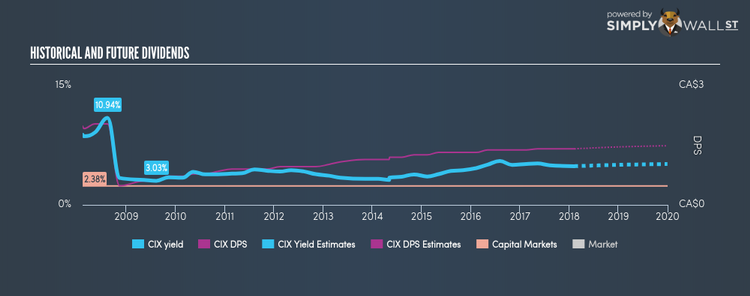Should You Buy CI Financial Corp (TSE:CIX) For Its Dividend?

A large part of investment returns can be generated by dividend-paying stock given their role in compounding returns over time. CI Financial Corp (TSX:CIX) has returned to shareholders over the past 10 years, an average dividend yield of 5.00% annually. Let’s dig deeper into whether CI Financial should have a place in your portfolio. Check out our latest analysis for CI Financial
5 checks you should use to assess a dividend stock
When assessing a stock as a potential addition to my dividend Portfolio, I look at these five areas:
Is their annual yield among the top 25% of dividend payers?
Has it paid dividend every year without dramatically reducing payout in the past?
Has dividend per share amount increased over the past?
Does earnings amply cover its dividend payments?
Will it be able to continue to payout at the current rate in the future?
How well does CI Financial fit our criteria?
The current trailing twelve-month payout ratio for the stock is 74.24%, which means that the dividend is covered by earnings. However, going forward, analysts expect CIX’s payout to fall to 57.62% of its earnings, which leads to a dividend yield of 5.08%. However, EPS should increase to CA$2.3, meaning that the lower payout ratio does not necessarily implicate a lower dividend payment. If there’s one type of stock you want to be reliable, it’s dividend stocks and their stable income-generating ability. Not only have dividend payouts from CI Financial fallen over the past 10 years, it has also been highly volatile during this time, with drops of over 25% in some years. This means that dividend hunters should probably steer clear of the stock, at least for now until the track record improves. In terms of its peers, CI Financial has a yield of 4.87%, which is high for Capital Markets stocks.
Next Steps:
Taking into account the dividend metrics, CI Financial ticks most of the boxes as a strong dividend investment, putting it in my list of top dividend payers. Given that this is purely a dividend analysis, I recommend taking sufficient time to understand its core business and determine whether the company and its investment properties suit your overall goals. There are three relevant factors you should further examine:
1. Future Outlook: What are well-informed industry analysts predicting for CIX’s future growth? Take a look at our free research report of analyst consensus for CIX’s outlook.
2. Valuation: What is CIX worth today? Even if the stock is a cash cow, it’s not worth an infinite price. The intrinsic value infographic in our free research report helps visualize whether CIX is currently mispriced by the market.
3. Other Dividend Rockstars: Are there better dividend payers with stronger fundamentals out there? Check out our free list of these great stocks here.
To help readers see pass the short term volatility of the financial market, we aim to bring you a long-term focused research analysis purely driven by fundamental data. Note that our analysis does not factor in the latest price sensitive company announcements.
The author is an independent contributor and at the time of publication had no position in the stocks mentioned.

